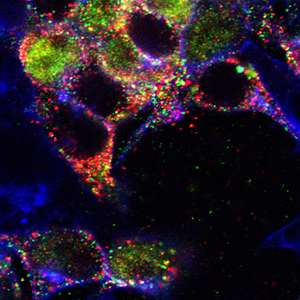Study sheds new light on asthma, COPD

In diseases such as asthma and chronic obstructive pulmonary disease (COPD), the body produces too much mucus, making breathing difficult. New research from Washington University School of Medicine in St. Louis provides clues to potentially counteract inappropriate mucus production.
"The new study lays the groundwork for developing treatments for diseases such as asthma, COPD, cystic fibrosis and even certain cancers," said senior author Thomas J. Brett, PhD, assistant professor of medicine. "It also solves a 20-year mystery about the role of a protein that has long been associated with these diseases."
The study appears March 17 in the journal eLife.
About two decades ago, the protein CLCA1 was identified. High levels of CLCA1 in cells lining the airway have long been linked with an overproduction of mucus. Studies at the time suggested CLCA1 was an ion channel, a small opening in the cell membrane that allows charged particles to flow into or out of the cell. CLCA1 was labeled a chloride channel because it appeared to be moving chloride ions across the cell membrane. In general, the movement of different ions into and out of cells govern many important processes from mucus production, to heart rhythms to brain function.
"Originally, CLCA1 was misidentified as a chloride channel," Brett said. "When cells express CLCA1, they produce chloride currents. But as we became better at understanding the three-dimensional structures of proteins, researchers in the field started to realize that CLCA proteins couldn't be channels. So the question arose, how do they activate these currents if they're not channels?"
Only seven years ago, a protein that proved to be this elusive type of channel was first discovered in mammals. Called TMEM16A, it is a channel that is ubiquitous in the cells lining the airway. Too much TMEM16A, like elevated levels of CLCA1, were also associated with the mucus-overproduction typical of airway diseases, including asthma and COPD.
The new research now has linked the two, demonstrating that increased expression of CLCA1 increases the number of TMEM16A channels present in nearby cells, according to Brett and his colleagues, including co-authors Colin G. Nichols, PhD, the Carl F. Cori Professor of Cell Biology and Physiology, Monica Sala-Rabanal, PhD, research instructor in medicine, and Zeynep Yurtsever, graduate research assistant.
"We don't think that CLCA1 actually opens the channel," Brett said. "In fact, the channel can function without CLCA1. We think it simply keeps the channel on the surface of the cells for a longer period of time. The reason you get more current is you have more channels there. You're just accumulating more holes for the ions to travel through. This is a unique finding. We don't know of any other examples of this type of interaction between a protein and a channel."
The study also suggests it may be worthwhile to investigate the larger families of these two proteins. If closely related members of these protein families also interact with each other, it could expand the implications to disorders as diverse as cancer and cardiovascular disease.
For example, TMEM16 channels and CLCA proteins have been associated with certain types of cancers including breast tumors that spread to the lungs and in some cardiovascular disorders such as irregular heart rhythms and heart failure, demonstrating a possible broad impact of future work in this area.
Brett said the team is continuing to study these interactions to learn more about how increasing or decreasing expression of the protein or the channel may influence the currents, and what impact that may have in airway diseases.
"In conditions leading to too much mucus, we may be interested in designing ways to block these currents or reduce them," Brett said. "On the flip side, these channel currents may be able to compensate for the genetic defect in cystic fibrosis, which causes mucus that is too thick and sticky. In this case, we may be interested in activating them or dialing them up."
More information: "Secreted CLCA1 modulates TMEM16A to activate Ca2+-dependent chloride currents in human cells." DOI: dx.doi.org/10.7554/eLife.05875

















